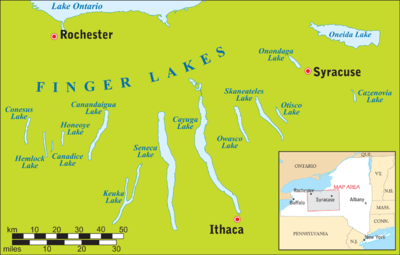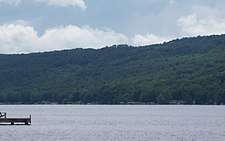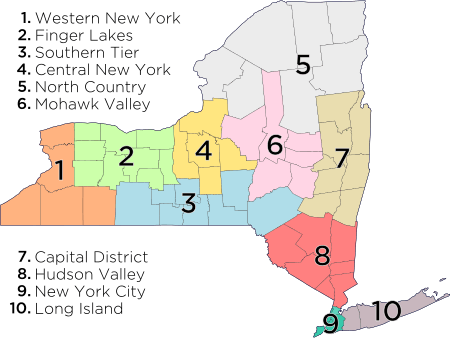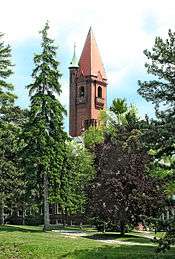Finger Lakes
The Finger Lakes are a group of 11 long, narrow, roughly north–south lakes in an area informally called the Finger Lakes region in New York, in the United States. This region straddles the northern and transitional edge, known as the Finger Lakes Uplands and Gorges ecoregion, of the Northern Allegheny Plateau and the Ontario Lowlands ecoregion of the Great Lakes Lowlands.[1]
The geological term finger lake refers to a long, narrow lake in an overdeepened glacial valley, while the proper name Finger Lakes goes back to the late 19th century.[2][3] Cayuga and Seneca Lakes are among the deepest in the United States—435 feet (133 m) and 618 feet (188 m) respectively—with bottoms well below sea level. Though none of the lakes' width exceeds 3.5 miles (5.6 km), Seneca Lake is 38.1 miles (61.3 km) long, and 66.9 square miles (173 km2), the largest in total area.[2]
Name
The origin of the name Finger Lakes is uncertain.[4] Currently, the oldest known published use of finger lakes for this group of 11 lakes is in a United States Geological Survey paper by Thomas Chamberlin[5] that was published in 1883. This paper was later cited and Finger Lakes formally used as a proper name by R. S. Tarr[6] in a Geological Society of America paper published in 1893.[7] Older usage of Finger Lakes in either maps, papers, reports, or any other documents remains to be verified.[4]
Lakes

The eleven Finger Lakes, from east to west, are:
- Otisco Lake
- Skaneateles Lake
- Owasco Lake
- Cayuga Lake
- Seneca Lake
- Keuka Lake
- Canandaigua Lake
- Honeoye Lake
- Canadice Lake
- Hemlock Lake
- Conesus Lake
Onondaga Lake to the east, although smaller, is sometimes called "the 12th Finger Lake", because it is similar in shape. It is in Appalachian hill terrain, with a historic village linked to other Finger Lakes by US 20. It may have been formed in the same manner as the Finger Lakes, as satellite photos show three valleys similar in character and spacing to the Finger Lakes east of Otisco Lake. The first is the Tully Valley, which includes a chain of small lakes at the south end that could be a "Finger Lake" that never formed because of a terminal moraine. The moraine caused the Tioughnioga River to flow south instead of north, the opposite of the Finger Lakes' waters. The next two valleys to the east contain Butternut Creek, which flows north, and the East Branch of the Tioughnioga River, which flows south. The next valley contains Limestone Creek, which flows north. The next valley after that contains Cazenovia Lake.

Oneida Lake, to the northeast of Syracuse, is sometimes included as the "thumb", although it is shallow and somewhat different in character from the rest. As with Onondaga and Cazenovia Lakes, it drains into Lake Ontario via the Oswego River and then into the St. Lawrence River ultimately draining into the Atlantic Ocean . Chautauqua Lake, Findley Lake and Kinzua Lake to the west are not considered Finger Lakes; all three drain into the Allegheny River and eventually into the Gulf of Mexico, and in the case of Kinzua and Findley, the lakes are the artificial creation of dams.
Conesus, Hemlock, Canadice, Honeoye, and Otisco are considered the minor Finger Lakes. Other, smaller lakes, including Silver, Waneta, and Lamoka lakes, dot this region. Silver Lake, west of Conesus Lake, would seem to qualify because it is in the Great Lakes watershed, but Waneta and Lamoka lakes are part of the Susquehanna River watershed as they drain into a tributary of the Chemung River.
East of Oneida and Cazenovia Lakes are the headwaters of the Susquehanna River and Hudson River watersheds (the former in the foothills of the Catskills, the latter through the Mohawk Valley and southern Adirondack Mountains).
The 2,000-acre (8 km2) muckland of a valley in Potter, New York, which is part of Torrey Farms, was almost a 12th Finger Lake, as the waterline is just below the surface. It lies between Lakes Canandaigua and Seneca, and was once a swamp.
Geology

These glacial finger lakes originated as a series of northward-flowing streams. Around two million years ago, the first of many continental glaciers of the Laurentide Ice Sheet moved southward from the Hudson Bay area, initiating the Pleistocene glaciation. These scouring glaciers widened, deepened, and accentuated the existing river valleys. Glacial debris, possibly terminal moraine left behind by the receding ice, acted as dams, allowing lakes to form. Despite the deep erosion of the valleys, the surrounding uplands show little evidence of glaciation, suggesting the ice was thin, or at least unable to cause much erosion at these higher altitudes. The deep cutting by the ice left some tributaries hanging high above the lakes—both Seneca and Cayuga have tributaries hanging as much as 120 m above the valley floors.[2]
Detailed studies of Marine Isotope Stage 3 and 4 age sediments exposed at a locality called Great Gully on the eastern flank of the Cayuga Lake, near Union Springs, New York, record the presence of a paleolake that existed prior to Cayuga Lake. This paleolake, which is called Glacial Lake Nanette, was a proglacial lake that filled the bedrock valley currently occupied by Cayuga Lake from about 50,000 BP calibrated until it was overridden by a glacial readvance that occurred prior to 30,000 BP calibrated and buried it beneath younger glacial till. This research shows that bedrock valleys, in which the Finger lakes lie, existed prior to the Last Glacial Maximum and developed over multiple glaciations.[3][8]
Ecological concern
Much of the Finger Lakes area lies upon the Marcellus Shale and the Utica Shale, two prominent natural gas reserves. Due to the recent increase in fracking technology, the natural gas is now accessible to extraction. While some large landowners have leased their lands, and a number of small landowners would like to follow suit, many residents of the Finger Lakes oppose the fracking process due to concerns about groundwater contamination and the industrial impact of the extraction related activities. The first direct actions and local legislative actions against fracking occurred in the Finger Lakes bioregion.[9] In December 2014, the government of New York banned all fracking in the state, citing pollution risks.[10]
History


The Finger Lakes region contains evidence of pre-Iroquois habitation, such as The Bluff Point Stoneworks, but little is known about who may have constructed these enigmatic structures.
The Finger Lakes region is a central part of the Iroquois homeland. The Iroquois tribes include the Seneca and Cayuga nations, for which the two largest Finger Lakes are named. The Tuscarora tribe lived in the Finger Lakes region as well, from ca. 1720. The Onondaga and Oneida tribes lived at the eastern edge of the region, closer to their namesake lakes, Oneida Lake and Onondaga Lake. The easternmost Iroquois tribe was the Mohawk.
During colonial times, many other tribes moved to the Finger Lakes region, seeking the protection of the Iroquois. For example, in 1753 remnants of several Virginia Siouan tribes, collectively called the Tutelo-Saponi, moved to the town of Coreorgonel at the south end of Cayuga Lake near present-day Ithaca, until 1779 when their village was destroyed.
Major Iroquois towns in the Finger Lakes region included the Seneca town of Gen-nis-he-yo (present-day Geneseo), Kanadaseaga (Seneca Castle, near present-day Geneva), Goiogouen (Cayuga Castle, east of Cayuga Lake), Chonodote (Cayuga town, present-day Aurora), Catherine's Town (near present-day Watkins Glen) and Ganondagan State Historic Site in Victor, New York.
As one of the most powerful Indian nations during colonial times, the Iroquois were able to prevent European colonization of the Finger Lakes region for nearly two centuries after first contact, often playing the French off against the British interests in savvy demonstrations of political competence. The renowned ingenuity and adaptibility of the Iroquois people were key tools of resistance against hostile European powers rapidly spreading throughout North America, eager to dominate and increasingly brutal toward native Americans in the Finger Lakes and beyond.
By the late 18th century with the French governmental influence gone from Canada Iroquois power had weakened, relative to the steady growth in European-Americans' populations, and internal strife eroded the political unity of the Iroquois Confederacy as they faced pressures from colonists itching to move west and a desire to keep them out of Amerindian lands. During the American Revolutionary War, some Iroquois sided with the British and some with the Americans, resulting in civil war among the Iroquois. In the late 1770s, British-allied Iroquois attacked various American frontier settlements, prompting counter-attacks, culminating in the Sullivan Expedition of 1779, which destroyed most of the Iroquois towns and effectively broke Iroquois power. After the Revolutionary War, the Iroquois and other Indians of the region were assigned reservations. Most of their land, including the Finger Lakes region, was opened up to purchase and settlement.
Roughly the western half of the Finger Lakes region comprised the Phelps and Gorham Purchase of 1790. The region was rapidly settled at the turn of the 19th century, largely by a westward migration from New England, and to a lesser degree by northward influx from Pennsylvania. The regional architecture reflects these area traditions of the Federal and Greek Revival periods.
Notable places

The Finger Lakes region, together with the Genesee Country of Western New York, has been referred to as the burned-over district.[11] There, in the 19th century, the Second Great Awakening was a revival of Christianity; some new religions were also formed.
The region was active in reform and utopian movements. Many of its Underground Railroad sites have been documented. For example, the Harriet Tubman Home at Auburn recalls the life and work of the African-American "Moses of her people."
On the northern end of the Finger Lakes are also Seneca Falls, the birthplace of the women's suffrage movement; Waterloo, the birthplace of Memorial Day; and Palmyra, the birthplace of The Church of Jesus Christ of Latter-day Saints. An annual outdoor drama, The Hill Cumorah Pageant, produced by the church, draws thousands of visitors each year.
Hammondsport was the home of aviation pioneer Glenn Curtiss, and favorable air currents make the area a popular spot for glider pilots. Elmira, just to the south, was the home of Mark Twain in his later life, and the site of an infamous Civil War prison. Corning is most noted as the home of Corning Glass Works and the Corning Museum of Glass. Hornell, just southwest of the Finger Lakes, was a major railroad center; locomotives were repaired there until recently. Conesus remains the home of the oldest producer of pure grape sacramental wine in the Western hemisphere.

Notable among the historic buildings of the region (most linked below) is the Granger Homestead (1816), a large village house in Federal Style at Canandaigua, New York. Another example of the Federal Style is the Prouty-Chew House (1829) at Geneva, portions of which were altered at various times in new fashions.
Three Greek Revival mansions are situated near three lakes: The Richard DeZeng House, Skaneateles (1839); Rose Hill, Geneva (1839); and Esperanza, Penn Yan (1838). The latter two are open to the public.
The Seward House in Auburn, a National Historic Landmark, is a mansion more characteristic of the Civil War era, virtually unchanged from the nineteenth century. Belhurst Castle, Geneva, a stone mansion in the Romanesque Revival style, now serves as an inn. Sonnenberg mansion at Canandaigua is later nineteenth-century residence in the Queen Anne style, known for its restored period gardens. Geneva on the Lake is a villa (1910–14) that recalls those on Italian lakes. Now an inn, it has European-style gardens. Many buildings and historic districts of the Finger Lakes region are notable, other than these historic houses.
Implemented in August 2010, the Hemlock-Canadice State Forest covers 6,684 acres (27.05 km2) that encompass the two western Finger Lakes, Hemlock and Canadice. These lakes have provided drinking water for the City of Rochester for more than 100 years. To protect water quality, the city acquired much of the property around the lakes. Over the decades, the land reforested, but a few traces of its past, such as stone walls or cottage foundations, remain. Today these two lakes, with their steep, forested, largely undeveloped shorelines and deep clear water, provide visitors a glimpse of the Finger Lakes of the past. The Department of Environmental Conservation (DEC) manages this State Forest for compatible public access for recreation, including fishing, hunting, nature study, boating and hiking. Activities in Hemlock-Canadice State Forest are subject the DEC's Rules and Regulations for the Use of State Lands, 6 NYCRR Part 190, as well as any other applicable state statutes, rules and regulations. These are sensitive areas because they protect public drinking water.
The 584 mile (939.9 km) Finger Lakes Trail and its branch trails run through the southern portion of the Finger Lakes region and also constitutes a portion of the 4,600 mile North Country National Scenic Trail.
Hemlock Lake is home to the state's oldest nesting bald eagle site, dating back to the early 1960s. The nesting bald eagles of Hemlock Lake have fostered a resurgence of bald eagles throughout New York State. Hemlock Lake, originally known as "O-Neh-Da" which is Seneca for "Lake of Hemlock Trees", is home to the nation's oldest sacramental winery, founded by Bishop McQuaid in 1872. Today, O-Neh-Da Vineyard continues to make premium natural pure grape wine for churches and foodies alike.
Wine

The Finger Lakes area is New York's largest wine-producing region. Over 100 wineries and vineyards are around Seneca, Cayuga, Canandaigua, Keuka, Conesus, and Hemlock Lakes. Because of the lakes' great depth, they provide a lake effect to the lush vineyards that flank their shores. Retaining residual summer warmth in the winter, and winter's cold in the spring, the grapes are protected from disastrous spring frost during shoot growth, and early frost before the harvest. The main grape varieties grown are Chardonnay, Riesling, Gewürztraminer, Pinot noir, Cabernet Franc, Vidal blanc, Seyval blanc and many Vitis labrusca (American native) varieties or cultivars.
With the passage of the Farm Winery Act in 1976, numerous wineries are now open to visitors. Wineries are a growth industry of the region, contributing through their production and by attracting visitors. The Finger Lakes American Viticulture Area (AVA) includes two of America's oldest wineries, O-Neh-Da Vineyard (1872) on Hemlock Lake and The Pleasant Valley Wine Company (1860) on Keuka Lake.
Craft beer
Aside from wine, the craft beer industry has exploded in the region, with the number of breweries doubling since 2012.[12][13]
Educational institutions
The area is also known for higher education learning. The largest is Ivy League institution Cornell University in Ithaca. Other notable schools are Ithaca College, also in Ithaca; Syracuse University, SUNY Upstate Medical University, State University of New York College of Environmental Science and Forestry, and Le Moyne College, in Syracuse; University of Rochester, Nazareth College, St. John Fisher College, Roberts Wesleyan College and Rochester Institute of Technology in Rochester; Elmira College in Elmira; Corning Community College in Corning; Tompkins Cortland Community College in Dryden, Ithaca, and Cortland; Wells College in Aurora; Hobart and William Smith Colleges in Geneva; Keuka College in Keuka Park; Finger Lakes Community College in Canandaigua and Geneva; and The State University of New York at Cortland in Cortland; New York Chiropractic College in Seneca Falls; Cayuga Community College in Auburn; and The State University of New York at Geneseo in Geneseo.
Museums
The Finger Lakes region is home to several museums. These include the Corning Museum of Glass, the Johnson Museum of Art at Cornell University, the Strong National Museum of Play, the Glenn H. Curtiss Museum, the Finger Lakes Boating Museum, the Wings of Eagles Discovery Center, the Sciencenter, the Museum of the Earth, the National Soaring Museum, the Rockwell Museum, the Seward House Museum, the William H. Seward and the Samuel Warren Homesteads of the New York Historical Society, birthplace of New York State's first successful commercial winery.
The Women's Rights National Historic Park is in Seneca Falls. The park includes the home of Elizabeth Cady Stanton and the Wesleyan Chapel, where she held the first convention on women's rights in 1848.[14]
References
Notes
- Bryce, S.A., Griffith, G.E., Omernik, J.M., Edinger, G., Indrick, S., Vargas, O., and Carlson, D., 2010, Ecoregions of New York: Reston, Virginia, U.S. Geological Survey, map scale 1:1,250,000.
- Mullins, H.T., Hinchey, E.J., Wellner, R.W., Stephens, D.B., Anderson, W.T., Dwyer, T.R. and Hine, A.C., 1996. Seismic stratigraphy of the Finger Lakes: a continental record of Heinrich event H-1 and Laurentide ice sheet instability. Geological Society of America Special Paper 311, pp.1-36 ISBN 9780813723112
- Kozlowski, A. L., and Graham, B. L., eds., 2014, Glacial geology of Cayuga County of the Eastern Finger Lakes–lakes, lore and landforms: Guidebook for the 77th Annual Reunion of the Northeastern Friends of the Pleistocene Meeting, Auburn, New York, 140 p.
- Brewster, M., 2016a. How The Finger Lakes Was Named: Part 1. Exploring Upstate.
- Chamberlin, T.C., 1882, Preliminary paper on the terminal moraine of the second glacial epoch: Third Annual Report of the United States Geological Survey, pp.291–402.
- Tarr, R.S., 1893. Lake Cayuga a rock basin. Bulletin of the Geological Society of America, 5(1), pp.339-356.
- Brewster, M., 2016b. How The Finger Lakes Was Named: Part 2. Exploring Upstate.
- Kozlowski, A.L., Bird, B., Mahan, Shannon, F., Robert, Teal, C., and Leone, J., 2018, Glacial Lake Nanette–a middle Wisconsin (MIS 4 – 3) proglacial lake in the Cayuga Basin, in Thorleifson, L. H., ed., Geologic Mapping Forum 2018 abstracts: Minnesota Geological Survey Open-File Report, 18-1, p. 41.
- "How fracking got stopped in NY".
- Kaplan, Thomas (17 December 2014). "Citing Health Risks, Cuomo Bans Fracking in New York State" – via NYTimes.com.
- Altschuler, Glenn C.; Saltzgaber, Jan M. (1983), Revivalism, Social Conscience, and Community in the Bured-over District: the Trial of Rhoda Bement, Ithaca, NY: Cornell University Press, ISBN 0801415411, LCCN 82014296, OCLC 8805286
- Cazentre, Don (2018-02-14). "Beer boom: New York state says it now has record number of breweries". newyorkupstate.com. Retrieved 2019-03-07.
- Gilcoo, Braden. "Finger Lakes Breweries: The 2 That You Must Visit".
- Women’s Rights National Historical Park - National Park Service
Basic Reading
- Thompson, John H., ed. Geography of New York State (Syracuse: Syracuse University Press, 1977)
- Engeln, O. D., von. The Finger Lakes Region: Its Origin and Nature (Ithaca: Cornell University Press, 1961, 1988)
- Finger Lakes Tourism Statistics
- House, Kirk W. and Mitchell, Charles R. Finger Lakes (Charleston, SC: Arcadia Publishing, 2008)
- Bloomfield, Jay A., ed. Lakes of New York State: Volume I: Ecology of the Finger Lakes (New York, NY: Academic Press, 1978)
External links
![]()

- Finger Lakes at Curlie
- The official Finger Lakes Tourism Alliance website




